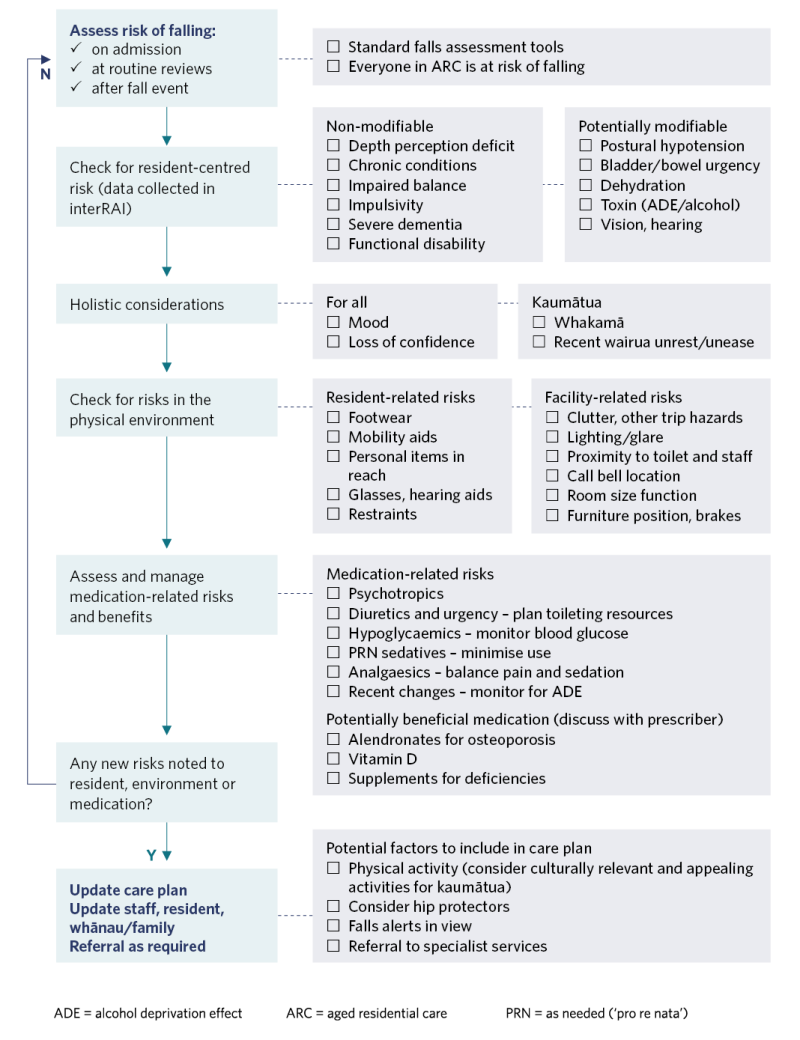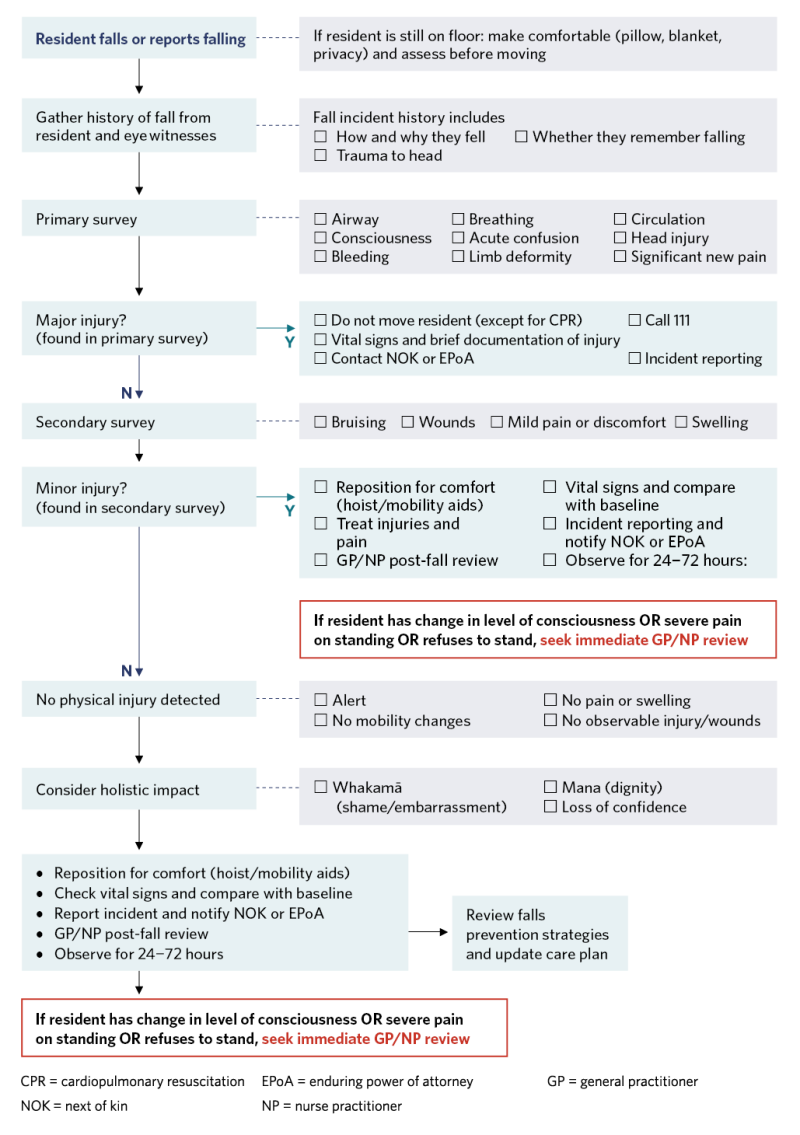To return to the list of all of the Frailty care guides | Ngā aratohu maimoa hauwarea, click here.
Contents
- Definition
- Why this is important
- Implications for kaumātua
- Assessment
- Treatment
- Care planning
- Decision support
- References | Ngā tohutoro
The information in this guide is accurate to the best of our knowledge as of June 2023.
Definition
A fall is any unintentional change in position where the person ends up on the floor or at another level lower than their previous position. It includes slips, trips and falls that occur while others are helping (World Health Organization 2021).
Key points
- Falls can indicate an underlying acute event, exacerbation of a chronic condition or frailty progress. Unwitnessed falls may be a syncopal event.
- Fall prevention programmes that address a range of different risk factors (multifactorial) can reduce the risk of falling and prevent many falls (Gulka et al 2020).
- Preventing and reducing the risk of falls is everyone’s business. It includes individual and population approaches (Cameron et al 2018; Health Quality & Safety Commission 2022f).
- Post-fall assessment is an important part of reducing future falls for the individual (Health Quality & Safety Commission 2022e).
Why this is important
Falls are the leading cause of unintentional injury in older people and are often a consequence of frailty (Health Quality & Safety Commission 2022a, 2022b). They can result in significant injury, functional decline (often related to a loss of confidence) and death (Health Quality & Safety Commission 2022e).
Key point
- In aged residential care (ARC), residents most at risk of falling are those needing help to transfer, those with impulsivity and people new to the facility.
Implications for kaumātua*
A Māori world view of ageing is based on a strength rather than a deficit model. Traditionally, kaumātua have a lot of mana (are held in high esteem).
Kaumātua may experience a sense of whakamā (shame, embarrassment) about their changing mobility and loss of independence. To avoid burdening others, they may not disclose falls, deny mobility challenges or be reluctant to use mobility aids or accept help.
If you encounter these kinds of responses, try reframing the situation to reflect a strength- based perspective (focusing on abilities, not deficits). An approach such as the following may be helpful.
We know how important your independence is to you, and we would like to support you to be independent for as long as possible. We also want you to have everything you need to keep yourself safe. Would you like to try this (mobility aid) to see if it helps you feel more comfortable/steady?
Whānau/family can be a useful source of valuable, culturally informed (mana-enhancing) interventions as they are invested in keeping their loved one safe. Involve them in care planning wherever possible.
See the Guide for health professionals caring for kaumātua | Kupu arataki mō te manaaki kaumātua for more information.
Assessment
Standard falls risk assessment tools are available (see your facility’s policy or procedure). However, almost all people living in ARC are at risk of falling (Health Quality & Safety Commission 2022c).
Treatment
At the individual level
- Focus on identifying and managing the individual’s risk of falling (physical environment and holistic).
- Provide strength, balance and gait training. Research shows it reduces the overall number of falls and fall events in people who have repeated falls in ARC (Gulka et al 2020).
- For kaumātua, consider culturally relevant and appealing activities that improve strength, balance and gait. These may include kapa haka (Māori performing arts), tītī tōrea (Māori stick game) and activities that contribute to the community they live in.
At the population level
Implement a facility-wide falls prevention programme. As part of the programme, consider the built environment, equipment, staff education, exercise programmes and access to allied health professionals (Health Quality & Safety Commission 2022d).
Care planning
- Plan individual care based on risks identified in falls risk assessment (see decision-support flowchart on the next page).
- Optimise management of chronic conditions.
- Remain alert for acute deterioration. (Falls can be a sign of acute deterioration.)
Decision support
Falls risk assessment (Cameron et al 2018; Health Quality & Safety Commission 2022c)

View a higher resolution version of this image in the relevant guide.
Post-fall assessment (Hampshire County Council 2015; Health Quality & Safety Commission 2022e)

View a higher resolution version of this image in the relevant guide.
References | Ngā tohutoro
Cameron ID, Dyer SM, Panagoda CE, et al. Interventions for preventing falls in older people in care facilities and hospitals. Cochrane Database Syst Rev 2018, Issue 9, Art. No.: CD005465. DOI: 10.1002/14651858.CD005465.pub4.
Gulka HJ, Patel V, Arora T, et al. 2020. Efficacy and generalizability of falls prevention interventions in nursing homes: a systematic review and meta-analysis. Journal of the American Medical Directors Association 21(8): 1024–35.e4. DOI: 10.1016/j.jamda.2019.11.012.
Hampshire County Council. 2015. Post-falls protocol for Hampshire County Council Adult Services. URL: www.nhs.uk/NHSEngland/keogh-review/Documents/quick-guides/background-docs/4-Hampshire%20falls%20protocol.pdf.
Health Quality & Safety Commission. 2022a. Topic 1 – Falls in older people: the impacts. URL: https://www.hqsc.govt.nz/our-work/system-safety/reducing-harm/falls/10-topics/topic-1-falls-in-older-people-the-impacts/.
Health Quality & Safety Commission. 2022b. Topic 2 – Which older person is at risk of falling? Ask, assess and act. URL: https://www.hqsc.govt.nz/our-work/system-safety/reducing-harm/falls/10-topics/topic-2-which-older-person-is-at-risk-of-falling-ask-assess-and-act/.
Health Quality & Safety Commission. 2022c. Topic 3 – Falls risk assessment: a multifactorial approach. URL: www.hqsc.govt.nz/our-work/system-safety/reducing-harm/falls/10-topics/topic-3-falls-risk- assessment-a-multifactorial-approach.
Health Quality & Safety Commission. 2022d. Topic 5 – Safe environment and safe care are essential to prevent falls. URL: https://www.hqsc.govt.nz/our-work/system-safety/reducing-harm/falls/10-topics/topic-5-safe-environment-and-safe-care-are-essential-to-prevent-falls/.
Health Quality & Safety Commission. 2022e. Topic 6 – After a fall: what should happen? URL: https://www.hqsc.govt.nz/our-work/system-safety/reducing-harm/falls/10-topics/topic-6-after-a-fall-what-should-happen/.
Health Quality & Safety Commission. 2022f. Topic 10 – An integrated approach to falls in older people what part can you play? URL: https://www.hqsc.govt.nz/our-work/system-safety/reducing-harm/falls/10-topics/topic-10-an-integrated-approach-to-falls-in-older-people-what-part-can-you-play/.
World Health Organization. 2021. Falls. URL: www.who.int/news-room/fact-sheets/detail/falls.
If you have feedback about the Frailty care guides | Ngā aratohu maimoa hauwarea, click here.
